October 24, 2008
Air Date: October 24, 2008
FULL SHOW
SEGMENTS
Controversy Over New Lead Regs
View the page for this story
The Environmental Protection Agency lowered the acceptable level of lead in the air for the first time in thirty years. Lead expert Dr. Bruce Lanphear served on the advisory panel to the EPA. He tells host Bruce Gellerman the new standard, ten times lower than the previous level, still isn’t low enough. (05:30)
Biden's Green Record
/ Jeff YoungView the page for this story
Joe the Plumber's been getting the attention lately, but what about Joe the Senator? What sort of environmental record would Senator Biden bring to the vice president's office? Living on Earth's Jeff Young takes a close look. (06:30)
Making the World A...
View the page for this story
Better Place, a California-based electric car startup, is selling a new way of driving. Australia just joined Israel and Denmark in inviting Better Place to put electric cars - and the infrastructure to power them -- on their roads in the next four years. Living on Earth's Bruce Gellerman talks with Wired Magazine writer Daniel Roth about Better Place's unique approach to greening roadways. (05:15)
California Greening
View the page for this story
California is the only state in the nation to put a hard limit on its carbon emissions in the absence of a federal policy. Now, the details of how much each part of the economy will have to clean up are becoming clear. Host Bruce Gellerman talks with chief of the California Air Resources Board, Mary Nichols. (05:30)
Buckets of Trout
/ Murray CarpenterView the page for this story
Brook trout are native to much of the eastern United States. But recent studies show that their populations are low in their historical habitat, primarily because of degraded streams, warming waters, and introduced fish species. In Maine, however, brook trout are thriving. Producer Murray Carpenter waded in the water with a team of Maine biologists to survey the state’s stream-dwelling trout. (05:45)
ECOtime
View the page for this story
The planet's natural calendar, with its cycles of hibernation, sprouting, fading and rebirth, can seem remote in our techno-filled lives. Tune in to the remedy: ECOtime. This week, we hear about flaming leaves. (01:30)
Fly-by-Night Murder Mystery
/ Bruce GellermanView the page for this story
Something is killing bats in the Northeast. Scientists have dubbed it “white nose syndrome” and believe a new fungus may be responsible for the mass die-off. On a dark and stormy evening, Living on Earth host Bruce Gellerman went out to crack the case. (07:30)
The Blood Feeders
View the page for this story
The gory habits of sanguivores don't just belong to vampire bats; birds, fish, bugs, and worms consume blood to survive, too. Are we missing out on gourmet cuisine? Bill Schutt, author of "Dark Banquet" talks with host Bruce Gellerman about blood and the creatures who love it. (08:30)
Show Credits and Funders
Show Transcript
Host: Bruce Gellerman
Guests: Bruce Lanphear, Mary Nichols, Daniel Roth, Bill Schutt,
Reporters: Murray Carpenter, Jeff Young
[THEME]
GELLERMAN: From Public Radio International, this is Living on Earth.
[THEME]
GELLERMAN: I’m Bruce Gellerman.
How green is Joe the Vice Presidential candidate? A scorecard on the Delaware Democrat.
MULLER: I would rate Senator Biden highly for his votes on national environmental legislation but a lot less highly for what he has done for Delaware.
GELLERMAN: Also, under court order, the EPA finally gets the lead out and tightens standards.
And a science sleuth stalks the mysterious mass killer of bats.
KUNZ: You can see the feces on the ground here. And over here’s our equipment, our camera and computer. You can see a few bats.
GELLERMAN: Oh …oh…
KUNZ: And if you look up on the ceiling there…
GELLERMAN: So you’ve got a thousand bats, you figure, in there?
KUNZ: Well, right now, with babies, there could be a thousand bats in here.
GELLERMAN: These stories and more this week on Living on Earth. Hang in there!
[MUSIC: Boards Of Canada “Zoetrope” from “In A Beautiful Place Out In The Country” (Warp Records 2000)]
ANNOUNCER: Support for Living on Earth comes from the National Science Foundation and from Stonyfield Farm.
[THEME MUSIC]
Controversy Over New Lead Regs
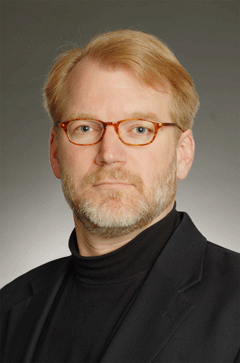
Bruce Lanphear
GELLERMAN: From the Jennifer and Ted Stanley studios in Somerville, Massachusetts, this is Living on Earth.
I’m Bruce Gellerman, in for Steve Curwood.
Lawmakers took the lead out of gasoline and paint 30 years ago, but the federal standards for lead particles in the air haven’t changed since then, even though we still continue to use lead, largely in car batteries and bullets for hunters, two-and-a-half million pounds a year. But even minute parts per billion of neurotoxic lead can cause birth defects, mental retardation, and behavioral disorders. So critics sued the U.S. Environmental Protection Agency, charging the three-decade-old lead standards were too lax. A federal court agreed, and only minutes before the EPA would have been found in contempt of court, the agency issued a new standard. Here’s EPA Administrator Stephen Johnson:
JOHNSON: These stronger standards tighten the allowable lead level ten times, to 0.15 micrograms of lead per cubic meter of air.
GELLERMAN: The new federal lead standards are actually at the upper end of a range recommended by an independent panel that advised the EPA. Dr. Bruce Lanphear was on that panel. He’s a health sciences professor at Simon Fraser University in British Columbia. And Dr. Lanphear, it seems your panel got what it wanted.
LANPHEAR: There’s a bit of bittersweet about it, Bruce. On one hand, yes, from the short-term perspective it’s really good to see this happen. From a longer-term perspective, it seems like lead poisoning and the pandemic - which is really worldwide - has been a failure of public health. We knew back in 1908, how to prevent childhood lead poisoning. But I think this was a reasonable compromise in a short term. I think we need to realize, though, that still, we’re quite a bit, evolutionarily speaking, above background levels and that this needs to be seen as part of a series of steps.
GELLERMAN: The EPA was brought into this kicking and screaming. They literally took a last minute decision on their part to avoid being held in contempt by a court. They were sued effectively and they had just minutes left to come out with this ruling.
LANPHEAR: Yes. This has become typical, certainly in the past decade or so, where EPA, CDC, many of the other federal agencies, really are quite reluctant to do anything that might harm industry profits. And I think one of the things as a society we need to begin to grapple with is, have we achieved a good balance? Are we adequately protecting public health from a whole host of environmental influences? Or are we erring too much on the side of protecting industry?

Bruce Lanphear
GELLERMAN: The devil really is in the details in this decision. They’ve got to monitor how much lead is in the environment, and my understanding is they don’t have the equipment, they don’t have a network of devices that will effectively measure this stuff.
LANPHEAR: That’s right. They let the monitoring system that was in place twenty to thirty years ago fall apart, and so now they’ve got to rebuild it.
GELLERMAN: So, is there money there to rebuild it?
LANPHEAR: Once a standard is promulgated there has to be resources towards monitoring. But I think it’s a big question, particularly in the midst of this financial crisis, that the United States is in the midst of.
GELLERMAN: The lobbying association for lead batteries said, “Look, you know, we’re actually doing a great job. We’ve got a hundred and fifteen million lead batteries that are in cars that we’re recycling. You know, what do you want from us?”
LANPHEAR: I’d like them to do better. Denmark did this fifteen years ago. They decided that over the next decade they would dramatically reduce or ban all non-essential use of lead. And I’d like to see industry take the next step, to be more proactive and say, “We’re going to invest in new technologies that don’t require lead at all.”
GELLERMAN: But they’re saying they don’t have the technology now and it’s going to cost them a fortune even if they did have it.
LANPHEAR: Well I think one of the things to recognize, Bruce, is that regulations serve many purposes. One purpose is to protect children’s health or the public health. The second is to help encourage industries to develop new technologies, to be innovative.
GELLERMAN: There have been, what, 6,000 studies or more done since 1978, the last time the lead levels were recalibrated and they had to get the lead out of gasoline, right?
LANPHEAR: Yes.
GELLERMAN: Is there any disagreement in any of those studies that any amount of lead in the environment is nasty?
LANPHEAR: I think that’s been the conclusion of every independent scientific group. What most people may not realize, is that the burden of proof is on public health or scientists to demonstrate the lead is a toxin. It should be the other way around. It should be that if I as a corporation or an industry want to use a product, I have to prove it’s safe before it’s used or before it’s marketed or before it’s released from my smokestacks. And so we set a very high bar. And in fact you might argue that the only time these regulations actually gain traction is when there’s significant public outcry, when the forces come together. And just having the scientists demonstrate that lead is a toxin at any level is not sufficient. There has to be enough outcry from the public for things to begin to change.
GELLERMAN: Well Dr. Lanphear, I want to thank you very much.
LANPHEAR: Thank you, Bruce.
GELLERMAN: Dr. Bruce Lanphear teaches at Simon Fraser University in British Columbia and was a member of the EPA’s lead advisory panel.
Related link:
The Environmental Protection Agency advisory panel on lead released this report before the decision
[MUSIC: Broadway Project “Countance/Magic Mirror” from In Finite (ODS Records 2008)]
Biden's Green Record
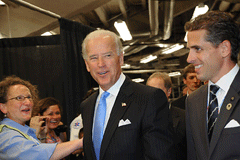
(Senator Joe Biden. Courtesy of the Democratic National Convention)
GELLERMAN: “It’s not worth a bucket of warm spit.” That’s the way FDR’s vice president once described his job - at least that’s the fit for broadcast version of the quote. But recent experience shows the vice president can play an influential role in crafting policy, especially on matters of energy and the environment.
Think Vice President Dick Cheney’s energy task force…or Al Gore’s actions on climate change. Since the next vice president is likely to play an equally critical role, we’ve been investigating the candidates’ green records.
This week: Senator Joe Biden, the Democrat from Delaware. Here’s Living on Earth’s Jeff Young.
YOUNG: The U.S. Congress has been nearly paralyzed by partisan fights, especially on issues as tough as global warming. But the Senate’s foreign relations committee has been the rare exception. That’s because the top Republican, Indiana’s Richard Lugar, found common ground on climate change with the top Democrat, Joe Biden.
BIDEN: Today I will join Sen. Lugar in introducing a new resolution on climate change. It says we should return to international negotiations under the UN framework convention, for time, to state the obvious, is not on our side.
YOUNG: That was Biden three years ago announcing a resolution he and Lugar have now moved through their committee three times. It’s a repeated rebuke to the Bush administration’s withdrawal from climate negotiations. Biden and Lugar also told their senior aides to monitor international talks. That means a lot of frequent flier miles for Mark Helmke, Lugar’s senior advisor. Helmke works for a Republican, but that doesn’t dampen his praise for the Democratic candidate’s grasp of the issue.
HELMKE: He has said over and over again that he’s very much aware of it, given the state he represents and the long and fragile coastline that it has. He also knows this is an issue very important to all our allies in the world, and we need to have good relations with our good allies and we need to talk to them about issues very important to them also.
YOUNG: The Lugar-Biden resolution never passed the full senate. But Elliot Diringer at the Pew Center on Global Climate Change says it still sent an important message, because it came from such important players.
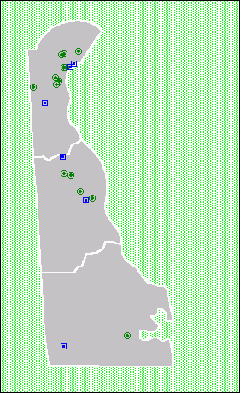
This map from EPA shows Delaware’s Superfund cleanup (NPL) sites
DIRINGER: Yeah, this is the committee that would have first consideration of any treaty that comes out of the negotiations and is submitted to the senate and yes, that message was heard by other governments and they took great encouragement from that. And I think that’s why some of them would be eager to see Senator Biden as part of a new administration.
YOUNG: So Biden clearly has a good head for foreign policy - a strength he’d apply to addressing climate change. His mouth however, is sometimes a weakness. Biden has a gift for the verbal gaffe, as he showed at a campaign event in Ohio last month. An environmental activist asked him about spending on so-called clean coal - the technology that aims to capture carbon dioxide from coal-burning power plants.
BIDEN: We’re not supporting clean coal. Guess what, China’s building…
YOUNG: Not supporting clean coal? Biden was in dangerous territory here. Senator Obama has made clean coal a key part of his pitch to coal-mining states like Ohio. But as Biden explained it, coal - clean or otherwise - should not be used in the US, but rather in China.
BIDEN: China’s gonna burn 300 years of bad coal unless we figure out how to clean their coal up because it’s gonna ruin your lungs and there’s nothing we can do about it. No coal plants here in America. Build ’em - if they’re gonna build ’em over there, make ’em clean because they’re killing us.
YOUNG: There’s a definition of the word “gaffe” in Washington: It’s a moment when a politician accidentally speaks the truth. Indeed, Biden’s Ohio comment was consistent with statements he made last year as a presidential candidate, when he said he did not see much role for clean coal in the U.S. Coal groups issued furious statements questioning Obama’s commitment to clean coal. And Obama energy advisor Jason Grumet had to do some damage control.

(Photo: Courtesy of the Democratic National Convention)
YOUNG: As vice president, Biden might need to mend some fences with lawmakers from coal-producing states. He might also bring to the administration a healthy skepticism toward coal industry claims about cleaning up its act. Biden has a very solid record on environmental issues. He sponsored bills to aggressively cut greenhouse gas emissions, and to promote fuel-efficient autos and battery research. And he voted against Bush administration efforts to weaken landmark laws like the Clean Air Act. The League of Conservation Voters scores him 83 percent pro-environment over his three-decade career. But some activists in his home state want him to pay more attention to Delaware’s environment. Alan Muller is with the grassroots group Green Delaware.
MULLER: I would rate Senator Biden highly for his votes on national environmental legislation, but a lot less highly for what he has done for Delaware.
YOUNG: Muller points to Delaware’s large chemical industry. The small state has a disproportionate number of highly toxic Superfund cleanup sites. Biden voted to reinstate a program that the Bush administration let expire that makes polluters pay for cleanup. But Muller says it takes more than votes to really get the job done.
MULLER: Biden has supported the reauthorization of the Superfund tax. And I think that’s to his credit. That was a national issue. But as far as supporting a thorough cleanup of many, many contaminated sites we have in Delaware, we just haven’t heard from him on those specific issues. And that’s where Biden has let us down.
YOUNG: Muller hints that Biden turns a blind eye to the environmental villains in his own backyard. But even that criticism comes with a nod to the senator’s strong record. A Vice President Biden would bring deep commitment and understanding to the biggest environmental problems. His peculiar way of communicating that, however, could be the biggest thing in his way.
For Living on Earth, I’m Jeff Young in Washington.
Related links:
- Biden’s energy and environment platform as senator and in his short run for
- League of Conservation Voters scores the Biden record
- Green Delaware on the state’s chemical contamination problems
[MUSIC: Thiervery Corporation “Retaliation Suite” from Radio Retaliation (ESL Music 2008)]
GELLERMAN: Just ahead, Eureka, California finds the green path to the future. Keep listening to Living on Earth!
[MUSIC: Gilfema: “One’s Mind’s Eye” from Gilfema + 2 (Oblique Sound 2008)]
Making the World A...
GELLERMAN: It’s Living on Earth, I’m Bruce Gellerman.
Entrepreneur Shai Agassi says he has a better idea….better than Ford, GM, or Toyota for that matter, and he’s not shy about his ambitions. He wants to clean up the world and make it a better place. Agassi plans to do it one electric car at a time, and Better Place just happens to be the name of his new company which he promises will make us rethink how we drive. Israel and Denmark were the first countries to sign up for the Better Place plan. Now Australia is on board, too.
Wired Magazine Senior Writer Daniel Roth has written about Better Place and its founder Shai Agassi.
ROTH: Shai figured out a new business model. You don’t usually hear about business models as being things that change the world, but he thought of a business model that would – he thinks – get us off oil. Thinking about cars like, as if they are cell phones. The way this would work is, basically, you would get your car through Shai’s company. He doesn’t make the cars. He only works with the car companies to make sure that they have cars that work on his standards. He buys the batteries and then you buy an electric car from him. You buy a plan. You get a certain number of miles per month that you can drive or you get an unlimited plan – it’s just like buying a cell phone. And he owns the battery. He swaps it out when it goes bad. He’s setting up battery exchange stations. You drive your car up, and in under five minutes the battery drops out from beneath the car and a new one pops up. And you don’t really care what battery you’re getting. You can get any old battery because you don’t own it. As long as it works, is all that matters to you.
GELLERMAN: So they key to his plan is actually setting up these fill-up stations - or battery drop-in stations.
ROTH: Well, yes – it’s two parts. One is the battery exchange stations. The other is charging spots. He thinks that he needs – at least in Israel – he says he needs one charging spot for every six parking spots in the country. That’s how he has decided that you’ll feel like you have ubiquitous charging. And he’s making sure that these cars have a PC inside of them to figure out where the closest charging spots are, when you need to get charged, whether you can make it or not. It will schedule you times to go get your batteries dropped out. As you’re driving into a parking spot it will tell you where the closest charging station is and whether it’s full or whether there’s a car there now or whether you can go plug in there. The idea is to make it not only as easy as possible to recharge a car, but sort of fun. You’ll drive and you’ll have on your dashboard a bubble around your car showing how much energy you’ve got, how far you can get, and how far you can press the limit. Then he’s thinking, down the road maybe a company puts up a charging spot and starts giving discounts - Charge a car, you go shopping at a Safeway and you get some discounts on things. It’s an incentive to charge at their store rather than charging at the neighbor’s store.
GELLERMAN: Well what about the costs. I mean, how much is it going to cost for the car? How much will it cost for the electricity?
ROTH: Shai is saying that the cost of this will be less than the cost you pay for gas each month. Deutsche Bank did a study of looking at whether what Shai was saying was true, and they came to the conclusion that yes, as a matter of fact, it will be cheaper to buy electrons basically instead of buy gas each month. As for the price of cars, Shai’s saying – and this one I think is going to be a little bit tougher to actually pull off – he in some cases will be able to give the cars away for free, that he’ll be making enough money on the monthly bills, what you pay each month for your car for the miles to him, that he’ll be able to just give away the car. We’ll see if he actually can do that. But even if he offers it as a subsidy that’s a pretty good deal.
GELLERMAN: It’s very clever.
ROTH: It’s very clever. It’s a really interesting idea. And you start - Shai is a - his secret is that he is so persuasive, and what he says makes sense, that when you hear it you start thinking, “Well, of course, this is how cars should be sold and this is how we’re going to drive electric cars. And why aren’t we doing this today? It doesn’t make any sense.”
GELLERMAN: Yeah, he talks a good deal. He talked investors into putting $200 million worth into his company.
ROTH: $200 million into a company that had nothing. It had no car company committed to it, it didn’t have any countries committed to this, and Shai basically said here’s how it’s going to work.
GELLERMAN: Who’s to say that the electricity used to power these cars is going to come from a clean source?
ROTH: That’s a big part of this that hasn’t been figured out yet. You need the utilities to commit to something like this. There is no one to say that he won’t just be getting electricity that comes through burning coal and is bad for the environment. But he basically says, “Look, I’m willing to pay a premium for the energy I’m buying from the energy companies as long as you can convince the energy company that you’re going to be putting the exact same number of clean electrons back onto the grid that I’m buying from you.”
GELLERMAN: Well, they don’t have the batteries, they don’t have the cars. It sounds a little bit pie in the sky.
ROTH: If something doesn’t work, this whole thing could fall apart, I suppose. But there are enough people that are betting on this, and that have a vested interested in making this happen, that it’s less pie in the sky and more risky business. You know, this is not just a start up – it’s a start up that’s taking on big oil and big auto. And it’s not going to be easy no matter what happens. But there’s money, there are engineers working on this. There’s one of the largest car companies in the world that’s committed to making these cars. Something’s going to happen here. Will it be as big and as grand as Shai thinks it will? I don’t know. We’ll have to wait and see.
GELLERMAN: Well, Daniel, thank you very much for sharing your story about Shai Agassi and his company, Better Place.
ROTH: Thank you for having me.
GELLERMAN: Daniel Roth is Senior Writer for Wired Magazine.
Related links:
- To read the Wired article about Better Place, check out Daniel Roth’s website
- Better Place
California Greening
GELLERMAN: When it comes to ambitious environmental standards and green policies, The Golden State has become the gold standard for the rest of the country. And now, California is setting the bar even higher; the state just released its final blueprint to dramatically reduce carbon emissions in every sector of its society. The limits go into effect New Year’s Day 2012, and the person in charge of putting the plan into action is Mary Nichols, chairman of California’s Air Resources Board.
Hello, Chairman Nichols.
NICHOLS: Hello.
GELLERMAN: So the plan is out, and I guess there’s been quite a bit of interest in it. People are downloading this document like crazy.
NICHOLS: Yes, it’s a best seller.
[LAUGHING]
NICHOLS: Of course, we’re not making any money off it, but we’re very happy that people are reading it.
GELLERMAN: These are really major reductions that you’re planning to make in greenhouse gas emissions. What does it work out to?
NICHOLS: Well, we are required by law – the state’s Global Warming Solutions Act – to return to 1990 levels by the year 2020. That translates into about a 30 percent reduction over business as usual.
GELLERMAN: So sort of back to the future – you’ve got to be in 2020 where you were in 1990, in terms of CO2.
NICHOLS: That’s right.
GELLERMAN: What industry or activity will need to reduce emissions the most under this scheme?
NICHOLS: Well, actually, probably the electric utilities have the most challenging target, because they not only have their own operations under their control, but because their product is used by so many of us. We’re asking them to be involved in helping their customers make reductions as well, but fortunately we have a lot of experience with that in California because we’ve had for decades now some of the most advanced electricity efficiency programs.
GELLERMAN: Well, you’ve had some pushback from the lobbying arm of the California Manufacturers and Technology Association. They say it’s going to add billions of dollars to ratepayers and utilities.
NICHOLS: Well, the CMTA is probably the leading organization other than the Western States Petroleum Association that is fighting back against the plan. They are running a big advertising campaign and what we called an Astroturf campaign - that is creating what are supposed to look like grassroots organizations of small businesses to try to slow down implementation.
GELLERMAN: Well some people are not very happy with the fact that you’re going to be allowing industries to buy up permits that they can trade on the open market, and that they’re going to get most of those – 90 percent of them – for free.
NICHOLS: Yes, probably the largest single number of comments that we got were from individuals, mostly organized through a Sierra Club website, who were protesting against the idea that businesses would be given these allowances for free. We intend to auction the allowances. We would start probably with a small share of the allowances being auctioned, you know ten, twenty percent, and then rapidly escalate.
GELLERMAN: There’s not a sector of the California society that this does not affect, especially something you have plenty of: sprawl. How are you going to deal with sprawl?
NICHOLS: Well [LAUGHS] we in California are known as the home of sprawl. We’re know for subdivisions that stretch out into the countryside and conversion of agricultural land and so forth, but this year, for the first time in many decades, the California legislature addressed the issue of urban sprawl signed by the governor just recently, which will allow for incentives for communities that practice smart growth by directing a larger share of the transportation funds and also giving some relief from some of our very burdensome permitting requirements. The problem is, of course, this won’t happen overnight. But we know for sure that we’ll never make it to our 2030 or 2050 goals, which are very dramatic, unless we get a handle on land use today.
GELLERMAN: You’re still going to have a lot of cars there. The Bush administration, which is on the way out, has really tied California’s hands on clean cars.
NICHOLS: We are still fighting with the Bush administration over the denial of a waiver under the Clean Air Act for California to enforce our clean car programs. We have been assured by both presidential candidates that we will get a waiver in the next administration, and we’re also suing along with thirteen other states in federal court. So one way or another we do expect to start enforcing this program next year. But, of course, we were delayed for almost two years as a result of the Bush administration’s foot dragging and intransigence.
GELLERMAN: Chairman Nichols, would it be overstating it to say that in California, at least, the era of dirty fossil fuels is drawing to a close?
NICHOLS: I think it would be fair to say that in California we are on the path towards a clean fuel and clean energy future. And I don’t think there’s any turning back.
GELLERMAN: Well Chairman Nichols, I want to thank you very much for your time.
NICHOLS: Thank you.
GELLERMAN: Mary Nichols heads up California’s Air Resources Board.
[MUSIC: Michael Franti :Soulshine” from Stay Human (Six Degrees Records 2001)]
Buckets of Trout
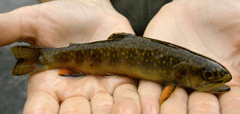
A brook trout from a central Maine stream. Brook trout populations have declined dramatically in the southern portion of their range, but many Maine streams still hold wild, native trout. (Photo: Murray Carpenter)
GELLERMAN: Brook trout were once plentiful in North America’s rivers and streams. You’d find them all the way from Georgia to Newfoundland, and as far west as Ohio. But the fish are now scarce in much of their former range, except for Maine. It’s the brook trout’s last, best refuge. It’s where for the past two years, state biologists have been surveying Maine’s waterways, and as Murray Carpenter reports, they’re finding plenty of trout.
[WADING SOUNDS]
CARPENTER: It’s 10 a.m. on a mild autumn day in rural Maine. Chip Wick wades up a stream wearing a fifty-pound backpack that holds an electrofishing unit. He turns it on…
[MACHINE BEEPS]
CARPTENTER: … and starts fishing. He waves a yellow wand in the water ahead of him, and trails a cable in the water behind. Wick’s three-person crew is searching for brook trout, and they don’t have to look too hard.
WICK: There’s one up here, right there, right underneath that stick, straight ahead, straight ahead, you got ‘em!
CARPENTER: As Wick wields the beeping shocker, Tyler Grant and Amy Preble handle the nets. Soon they’ve got five trout in the bucket.
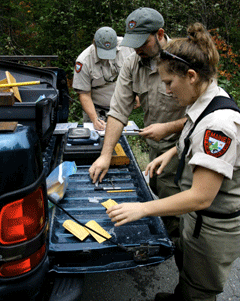
Maine Department of Inland Fisheries and Wildlife biologists Chip Wick, Tyler Grant and Amy Preble use the tailgate of their pickup as a streamside lab. After they measure the brook trout and take tissue samples for later analysis, they release the fish back into the stream. (Photo: Murray Carpenter)
WICK: That’s five of ’em, you can see they are stunned for a little while, but they come back out of it pretty quickly.
CARPENTER: Ten yards from the road, and you’ve got a bucket full of trout.
WICK: Yep, yep, pretty small stream, it doesn’t look like much more than a drainage ditch really. But if they’ve got a constant flow of water and the right water temperatures, they can hold trout year round.
CARPENTER: After sampling a 50-yard reach of stream, the crew carries the bucket back to the tailgate of the pickup, which they transform into a sort of field lab. First they measure the trout.
WICK: Number one is 120 millimeters … 13.8 grams…
CARPENTER: Then they clip some fin tissue for later genetic analysis, and scrape off a few scales for growth studies. Soon the trout go back into the brook.
This study was prompted by a 2005 report by a coalition called the Eastern Brook Trout Joint Venture. The report showed that wild brook trout are missing or greatly reduced in nearly half of their historic range, because of degraded streams, warming waters and competition from introduced fish. The report also noted that the fish are assumed to be thriving in most of Maine, which is further north and less developed than other states with brook trout, but quantitative data was missing.
GALLAGHER: For lake and pond habitats we have about 97 percent of the nation’s resources. But we couldn’t say that for stream habitats because we did not have adequate data.
CARPENTER: Merry Gallagher, a biologist with the Maine Department of Inland Fisheries and Wildlife is leading the Maine brook trout study. She says trout in the southern part of the range are limited by a lack of cold, clean water, and have been harmed by a variety of land uses.
GALLAGHER: It’s agricultural and development concerns. In some of the Appalachian regions of West Virginia, Pennsylvania, it’s mining practices because severe degradations in water quality that don’t allow trout to persist, and other fishes in many cases, too.
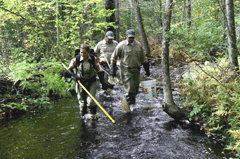
While Amy Preble wields the electrofishing unit, which includes a 50-pound backpack, Chip Wick and Tyler Grant catch temporarily stunned fish in their nets. This Penobscot County stream was holds a good variety of minnows, and plenty of brook trout.
CARPENTER: Gallagher says brook trout are good indicators of healthy watersheds. That’s why the Eastern Brook Trout Joint Venture is considered a pilot project for a series of national fish habitat action plans.
GALLANGHER: So we’re talking about an animal that needs to move freely, has relatively strict habitat requirements as far as water quality and the physical features of its habitat, so it’s a good animal for a large-scale conservation effort, which is what we are striving for.
CARPENTER: The sampling project cost about $250,000 a year. It was primarily funded with federal dollars, with support from the state of Maine and some money from nonprofits such as Trout Unlimited.
Jeff Reardon is Trout Unlimited’s New England conservation director.
REARDON: Maine is to brook trout what Alaska is to Pacific salmon, it’s the place you have large numbers of intact populations in the streams they evolved in, in something like their natural state. That’s pretty remarkable if you think about the changes we’ve put on these watersheds over the last three or four hundred years.
[RIPPLING WATER]
CARPENTER: Back in central Maine, Wick’s crew surveys the third of four sites they’ll cover today. In addition to looking for trout, they test water quality, and generally evaluate the habitat. While many of Maine’s lakes and large rivers have already been overrun by non-native fish like smallmouth bass, most little streams still hold a variety of native fish. The crew tallies these on their data sheets.

A brook trout from a central Maine stream. Brook trout populations have declined dramatically in the southern portion of their range, but many Maine streams still hold wild, native trout. (Photo: Murray Carpenter)
GRANT: Common… blacknose… creek chub… finescale… We’ve got another brookie here.
CARPENTER: While the crew sorts fish, Gerald Myrick stops by to see what’s going on. An outdoorsman wearing a camouflage baseball cap, he lives just up the road and says he knows this tiny brook well.
MYRICK: I’ve lived here all my life, and I’ve fished it all my life, so yes, I know there’s trout here. A lot of times this one’s almost dry, but you’ll find a hole with six inches of water, and you’ll find the trout.
CARPENTER: Myrick’s observation seems to sum up the situation in much of Maine, where the sampling crews have been surprised to find trout even in muddy little trickles. This winter, biologists Wick and Gallagher will be working indoors, mapping their findings. And many of those vast areas of the Maine brook trout distribution map that now say, “no quantitative data” will soon read “populations intact,” at least for now.
For Living on Earth, I’m Murray Carpenter, in Penobscot County, Maine.
MYRICK: Brookie, nice brookie!
ECOtime
GELLERMAN: Feel like you’re spending too much time indoors and out of touch with the great outdoors? Well the folks at the ECOcalendar project have just the thing to pick you up and get you heading for the hills. It’s a feature Living on Earth will be airing in the coming months, called ECOtime.
HARDMAN: Flaming leaves. Deciduous means to fall away, and deciduous trees, such as poplar, dogwood, beech, maple, birch and oak, shed their leaves in the fall.
Leaves are solar panels that use chlorophyll to transform those golden rays of sunshine into sugar stored in sap. Chlorophyll is green so throughout spring and summer we're shaded beneath a cool canopy of luxuriant greenery, but come fall, the shorter days mean less sunlight, signaling to the deciduous tress that it’s time to hunker down for winter, cease their production of chlorophyll, and prepare to jettison their leaves.
Thus, the leaves lose their green and instead transform, in their final days, into the colors of the summer sun itself - russet, yellow, red, crimson...as they flame out in a final homage to that fiery energy ball which is the sun.
GELLERMAN: That's Chris Hardman with ECOtime, part of the ECOcalendar project coming soon on Living on Earth. For more information, go to loe.org.
Related link:
ECOtime on Living On Earth is part of Chris Hardman's ECOlogical Calendar
[MUSIC: Minimal Compact “Autumn Leaves” from There’s Always Now (Remixes & Remakes) (Crammed Disc 2008)]
Coming up: They vant to suck your blood - the lives of sanguivores. Get out your garlic - it’s Living on Earth.
ANNOUNCER: Support for the Environmental Health Desk at Living on Earth comes from the Cedar Tree Foundation. Support also comes from the Richard and Rhoda Goldman fund for coverage of population and the environment. And from Gilman Ordway for coverage of conservation and environmental change. This is Living on Earth on PRI, Public Radio International.
[MUSIC: Carlos Santana: “En Aranjuez Con Tu Amor” from Multi-Dimensional Warrior (Legacy Records 2008)]
Fly-by-Night Murder Mystery
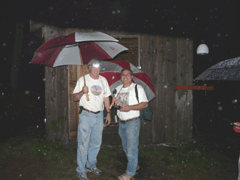
Tom Kunz and Bruce Gellerman in front of the bat roost. (Photo: Bruce Gellerman)
GELLERMAN: It’s Living on Earth, I’m Bruce Gellerman
[THUNDER AND HEAVY RAIN]
GELLERMAN: It was a dark and stormy evening, a pitch-black night, the kind that sends a shiver down your spine.
In the shadows, a mystery that’s baffling scientists across the country: virologists, mycologists, reproductive biologists, and immunologists: Why colonies of bats in the northeast are dying - whole caves full of ’em.
For answers I drove to Paxton, Massachusetts, and let me tell you, I quickly found out cracking this case was going to be tough going.
KUNZ: I went the wrong way. Hold it, we got to go up there…
GELLERMAN: Tom Kunz leads the way up slippery rocks and wet, thorny bushes and past a waterfall in Moore State Park. The rain pelts my umbrella and hits my mic, with a snap, crackle and pop.
Even with his headlamp and my flashlight it’s difficult seeing the path, but Kunz knows the way - he’s been coming here for nearly a quarter of a century. Kunz directs Boston University’s Center for Ecology and Conservation. He’s been studying nocturnal flying mammals since he was a kid. Kunz is a chiropterologist. His students simply call him: Batman.
KUNZ: I fell in love with bats…I thought this is the coolest thing I could ever do with my life, and I never turned back.
GELLERMAN: Pressing on we arrive at a weathered wood hut. It’s a maternity ward of sorts, filled with mom bats and their baby pups.
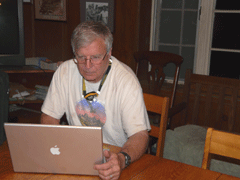
Tom Kunz (Photo: Bruce Gellerman)
KUNZ: So it’s a little bit bigger than a backyard shed. And as we go inside, we built a module that fits up in the attic of this building where the bats are roosting in crevices.
[SOUND OF DOOR OPENING]
GELLERMAN: It’s spooky inside. The rain has put a damper on the bats evening flight for food. Little brown bats like these can make more than 20 miles an hour flying like bats out of - well, you know…
KUNZ: You can see the feces on the ground here. And over here’s our equipment, our camera and computer. You can see a few bats flying…
GELLERMAN: Oh…oh…
KUNZ: …and you look up at the ceiling there see there…up there…That’s where they roost.
GELLERMAN: So about a thousand bats, you figure, in there?
KUNZ: Well, right now, with babies, there could be close to a thousand bats in here, yeah.
GELLERMAN: This colony seems okay, but Jonathan Reichard, a grad student in Professor Kunz’s lab, says in hibernaculum mines and caves in four northeast states, New York, Vermont, Connecticut and Massachusetts, bats that are supposed to be there are missing - whole colonies decimated.
REICHARD: In those mines they can’t necessarily account for all of the dead bats, they just know they’re not there, because they haven’t found the floors littered – in many cases, they haven’t found the floors littered with carcasses.
KUNZ: Two years ago - was the first time, it was the winter of 2006-2007.
GELLERMAN: Professor Tom Kunz says the first case was found in a cave near Albany, New York. The dieoffs were slow at the beginning.
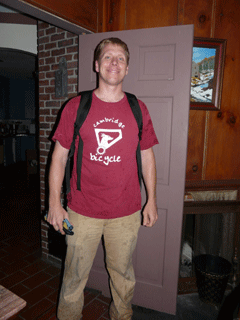
Jonathan Reichard. (Photo: Bruce Gellerman)
KUNZ: It is very bizarre, yeah. Only in about four or five caves during that winter, did they see evidence.
GELLERMAN: But the evidence quickly mounted. Actually, it was a lack of evidence - missing bats. In some caves, a hundred percent gone. And when scientists did find bats, they found a weird white fungus growing on the face, wings and ears. Scientists dubbed it White Nose Syndrome. Professor Kunz calls it circumstantial evidence.
KUNZ: White Nose syndrome is, at least to the best of our knowledge right now, is sort of the external manifestation of whatever is causing these bats to become ill and die.
GELLERMAN: So it seems to me you’re not sure whether this is cause or effect - whether the fungus is a symptom, or it’s actually killing them?
KUNZ: Exactly.
GELLERMAN: For clues to why bats are dying, scientists are trying to understand more about how they live. Bats make up 20 percent of the mammal species, but there are huge gaps in our knowledge. Bats are no fly-by-night species. They play critical roles in the environment. The little brown bats here feast voraciously in the summer and fall, on insects.
KUNZ: Insectivorous bats typically eat anywhere between two thirds to their entire body weight in insects.
GELLERMAN: In one night - they eat two thirds of their entire weight…a night?
KUNZ: Yeah, Two-thirds to their entire weight, yeah, 100 percent – now, that’s a lot of eating. This would be equivalent of a hundred-pound person eating 400 quarter-pounders a night.
GELLERMAN: Bats make meals of moths, beetles, midges and flies, storing the fat, stocking up in the late fall - right about now - for winter. For six months they’ll hibernate in caves and mines, attics and sheds, living in a state of torpor, when the bat’s metabolism slows way down and their body temperatures drop. That’s the way it’s supposed to be - but Professor Kunz says scientist have found where there’s white nose syndrome something else is going on.

Tom Kunz and Bruce Gellerman in front of the bat roost. (Photo: Bruce Gellerman)
KUNZ: Basically what’s happening is by midwinter, these bats have lost all their body fat, in effect. So if you don’t have enough fat to sustain hibernation, you don’t have enough energy to arouse, and you die.
GELLERMAN: They’re just wasting…
KUNZ: They’re wasting away - that’s right - they’re exactly wasting away.
GELLERMAN: It may be the bats are affected by the white nose fungus in the fall and are too weak to gather enough insects for winter, or maybe the fungus is causing the bats to wake during hibernation.
It’s kind of like when you get athletes’ feet - it’s not going to kill you, but it’s going to irritate you. So there may be some level of irritation that these hibernating bats experience - which may cause them to become more active and arouse and so on. This is still a hypothesis.
GELLERMAN: Aroused early from hibernation - and starving - perhaps the bats fly off into the winter…and die.
Caves are cold, dank places and a hibernating bat is like a tub of cottage cheese in the back of a refrigerator - a perfect medium for fungus and bacteria. Over millions of years, bats have developed immunity to most molds and disease, but white nose is different. It’s new. It’s unlike any other fungus seen before, it thrives in very cold temperatures. And even in professor Kunz’s lab where undergraduate Katherine King works, there are conflicting theories about white nose and what’s causing the bats to die.
KING: Personally I think it’s a combination of changes in the environment, different changes that have been caused by human interaction and things like that I think the fungus is probably a secondary symptom of something that’s a problem in the bats - but we simply don’t have a clue as to what that is.
GELLERMAN: Well if it’s not the white nose syndrome that’s killing the bats, what is it?
KUNZ: Well I’ve got several hypotheses here.
GELLERMAN: Again, Batman - professor Tom Kunz.
KUNZ: It has to do with fat. And it has to do with insects and it has to do with other potential reasons why insect populations around the world are declining. You may or may not know this, but insect populations - in particular, moths and some beetles, for example in New York State, a little lady bug beetle is going down the tubes. So this leads to the hypothesis there’s a reduction in the number of insects that are available to bats during the fall of the year, when they need that fuel to deposit fat to successfully hibernate.
GELLERMAN: This is still just a hypothesis, just a theory, but one thing is certain: bats which are critical to holding the population of insects in check and play important roles in pollinating forests, are dying in large numbers in New England. And bats in caves could be like the canary in the coal mine.
Related links:
- For more on Kunz’ work, click here
- To learn more about the bats of New York, click here
The Blood Feeders
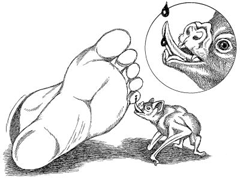
(Illustration: Patricia J. Wynne)
[SCARY MUSIC: Dracula, Universal Pictures]
GELLERMAN: It’s that time of year again… Bat time. When bats inspire and scare many a trick-or-treater.
[SCREAM]
GELLERMAN: Bats have also inspired many a B-movie: B, as in Bela.
LUGOSI: This is very old wine. I hope you will like it.
MAN: Aren’t you drinking?
LUGOSI: I never drink - wine.
GELLERMAN: You know what he drinks. And he’s not the only one with a fetish for the vital fluid.
Turns out there are over a thousand species that drink - blood. Collectively, they’re known as sanguivores, and Bill Schutt chronicles their gruesome ways in his new book “Dark Banquet: Blood and the Curious Lives of Blood-Feeding Creatures.” Bill Schutt is an associate professor of biology at Long Island University, and Professor, welcome to Living on Earth. Or should I say “I bid you velcome”!
SCHUTT: [LAUGHS] It’s great to be here, thanks for having me on.
GELLERMAN: Out of all the creepy animals you write about, I think the creepiest is the Candiru. Have I pronounced that correctly?
SCHUTT: Yeah, the vampire catfish. These are creatures that primarily feed underneath the gill covers of many large species of fish. They’re about maybe the size of a pencil, sort of shaped the same way. They wiggle their way underneath the gill cover, and they’ve got these things called odontodes, little spiky tooth-like structures all over their heads. And they just sort of clamp on with their jaws, shake their heads and the blood that then is released into the water is what they feed on, and they use their jaws to pump that blood down into their digestive track. But the problem is there have been several occurrences where these creatures have taken a wrong turn and wound up in the human urethra, which presents a problem not only for the fish but for the person who’s had this thing swim up them.
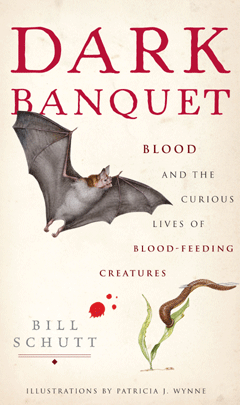
"Dark Banquet"
GELLERMAN: Oooooh. I’m getting creepy just listening to you.
SCHUTT: Yeah – highly unlikely, though.
GELLERMAN: Why do animals feed on blood? How do they evolve? Where do they first come from?
SCHUTT: Well, for instance, bed bugs are creatures that we believe evolved to prey on bats and other cave dwelling creatures. And then it was just a matter of them switching hosts when humans moved into these caves. And vampire bats, for example - I believe that vampire bats evolved from related bats that were feeding on creatures that were creeping around in the trees. It was more of a carnivore-prey relationship, and ten or so million years ago when some larger creatures started to evolve and show up in the trees then natural selection worked to select features that enabled the bats to be able to prey on these large creatures that they couldn’t just jump on and kill.
GELLERMAN: You write that the vampire bats are the most highly specialized of all living mammals. How’s that?
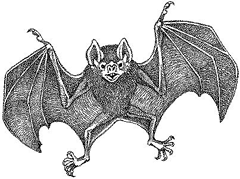
(Illustration: Patricia J. Wynne)
SCHUTT: There’s a list – a fascinatingly long list – of adaptations that they have to be able to access this, this resource. Wildly sharp, highly evolved teeth, anticoagulants in their saliva, heat sensors on their muzzles. Their kidneys are specially adapted to concentrate and eliminate high quantities of water, because blood is mostly water, and these animals can’t deal with all that weight if they’re going to fly. So while they’re feeding their kidneys are actively processing this water and getting rid of it. So, there are all sorts of anatomical features that have evolved to enable this creature to feed on blood.
GELLERMAN: You write that while at Cornell University, doing your graduate work there was an experiment of sorts. They put a pair of vampire bats in a cage with a large hen. And I guess these little vampire bats are very, very small – they weigh like an ounce or something. And instead of backing off, instead of pecking at the bats, the bird kind of just sits there. And you write this: “Instead of becoming alarmed, the bird seemed to relax a bit. The vampires responded by pushing itself deeper into what I would later learn was a sensitive section of feather free skin called the brood patch. This was a region densely packed with surface blood vessels, where blood heat could be efficiently transferred from the hen to her eggs. Later the brood patch was where the chicks snuggled up to warm themselves. And as I watched, the hen reacted to the bat by fluffing her feathers, hunkering down and finally, closing her eyes.” Boy, that’s worthy of Bram Stoker.

(Illustration: Patricia J. Wynne)
SCHUTT: Thanks. That’s a compliment where I come from.
GELLERMAN: It’s pretty creepy, is what it is.
[LAUGHING]
SCHUTT: We were sort of freaked out when we saw it as well. I mean, they’re mimicking chicks. So the natural response of the female hen when it gets snuggled in that region is to relax and hunker down and warm its chicks up. And in this instance, the bats have mimicked that behavior as a way to get access to the bird. So while the bird is relaxing, the bat is underneath the bird feeding.
GELLERMAN: You pull off something of a hat trick in your book, I must say. Not only do you deal with vampire bats, you also talk about the death of George Washington and the movie classic “African Queen.” They all have something in common.
SCHUTT: Yeah, I had a ball with that. “African Queen” is one of my favorite movies, and once I started to write the leech chapter, I thought it might be interesting to write the famous Humphrey Bogart leech scene from the point of the view of the leeches themselves.
[SCREAM from film clip]
BOGART: Ooh, ooh, ooh, the little buggers.

(Illustration: Patricia J. Wynne)
GELLERMAN: That’s when Humphrey Bogart as Charles Allnut, is taking the boat down the Tanzenica and he goes in the water to pull the boat and – well, it’s pretty gross.
SCHUTT: Yeah. “Leeches – I hate the little buggers.”
BOGART: If there’s anything in the world I hate, it’s leeches. Ooh. Filthy little devils.
GELLERMAN: Leeches –they’re animals which actually doctors now breed.
SCHUTT: In modern medicine, leeches are used after reattachment surgeries. When something like a finger is reattached, if you put leeches around that reattachment site they draw off the blood that would otherwise collect or possibly clot it in that area. And so they are an aid to the surgeon until the body can heal itself.
GELLERMAN: These animals, they all have chemicals which prevent the blood from sticking together and forming a clot.
SCHUTT: Yeah, if there was no anticoagulant being applied in their saliva, for example, then the body’s natural clotting processes would kick into gear rather quickly and you’d have – the wound would close off, the blood would stop within – you know – a couple of minutes. So these anti coagulants just keep that, that food source flowing for as long as the vampire needs to feed.
GELLERMAN: And these anticoagulants, these naturally occurring anticoagulants are far more complex and far more powerful than the ones that we ordinarily use in medicine today.
SCHUTT: Right. Which is one of the reasons why these creatures need to be conserved. It’s sort of a knee jerk reaction to think that oh, blood feeders, let’s just annihilate them all. But in reality, modern medicine is encountering substances that these creatures have been using for millions of years, that are turning out to be a benefit for modern science and medicine.

Author Bill Schutt (Photo: Jerry Ruotolo)
GELLERMAN: Are you suggesting then that we should actually raise these, these blood-sucking animals, to save them?
SCHUTT: Well, it depends. If you’re talking about mosquitoes, certainly not, but if you’re talking about two of the three species of vampire bats that are threatened, then certainly. I mean we only have 5,000 species of mammals left on this planet right now and to have two of them face extinction is something that a lot of people might have a problem with. They certainly need to be controlled. The common vampire bat is a problem, and it’s really a problem because humans go in, trash the rain forest, bring in cattle and now that area with its thousands and thousands of cattle can now support large vampire bat populations. The other two vampire bats feed on birds, and they’re generally not problematic.
GELLERMAN: Professor, are you going to go to a Halloween party this year?
SCHUTT: Certainly, yeah. The Halloween party that we’re going to, is going to see Alice Cooper in Connecticut. Alice Cooper was supposedly the guy who killed the chicken on stage back in the Cretaceous era, I think. So that’s about as Halloween-y as you can get.
GELLERMAN: Bill Schutt’s new book is called “Dark Banquet: Blood and the Curious Lives of Blood-Feeding Creatures.” Professor Schutt, thank you very much, really appreciate it.
SCHUTT: It was a pleasure being on your show.
Related link:
Hungry for more blood? Get pictures, information, and recipes at the “Dark Banquet”
[MUSIC: Alice Cooper “Fresh Blood” from Dada (Warner Bros 2007)]
GELLERMAN: On the next Living on Earth, the price we pay for the things we value:
SUKHDEV: Why are some things worth money and some things not? How come that I can watch a sunset for free and how come I have to pay for a movie? There is this aspect of ignoring value when it doesn’t transact in markets and that’s the key.
GELLERMAN: Putting a price tag on nature - next time on Living on Earth.
Living on Earth is produced by the World Media Foundation. Our crew includes Ashley Ahearn, Bobby Bascomb, Eileen Bolinsky, Ingrid Lobet, Helen Palmer, Mitra Taj and Jeff Young, with help from Sarah Calkins and Marilyn Govoni. Our interns are Sandra Larson and Jessie Martin. Jeff Turton is our technical director. Alison Lirish Dean composed our themes. Steve Curwood is our executive producer.
You can find us at loe.org.
I’m Bruce Gellerman. I vant to tank you for listening.
ANNOUNCER: Funding for Living on Earth comes from the National Science Foundation, supporting coverage of emerging science, and Stonyfield Farm: organic yogurt and smoothies. Stonyfield pays its farmers not to use artificial growth hormones on their cows. Details at stonyfield.com.
Support also comes from you our listeners, the Ford Foundation, the Town Creek Foundation, the Oak Foundation supporting coverage of climate change and marine issues; the Skoll Foundation, supporting social entrepreneurs around the world – uncommon heroes dedicated to the common good. Learn more at skoll.org; and Pax World Mutual Funds: socially and environmentally sustainable investing. Pax World: for tomorrow. On the web at paxworld.com.
ANNOUNCER2: PRI, Public Radio International.
Living on Earth wants to hear from you!
Living on Earth
62 Calef Highway, Suite 212
Lee, NH 03861
Telephone: 617-287-4121
E-mail: comments@loe.org
Newsletter [Click here]
Donate to Living on Earth!
Living on Earth is an independent media program and relies entirely on contributions from listeners and institutions supporting public service. Please donate now to preserve an independent environmental voice.
NewsletterLiving on Earth offers a weekly delivery of the show's rundown to your mailbox. Sign up for our newsletter today!
 Sailors For The Sea: Be the change you want to sea.
Sailors For The Sea: Be the change you want to sea.
 The Grantham Foundation for the Protection of the Environment: Committed to protecting and improving the health of the global environment.
The Grantham Foundation for the Protection of the Environment: Committed to protecting and improving the health of the global environment.
 Contribute to Living on Earth and receive, as our gift to you, an archival print of one of Mark Seth Lender's extraordinary wildlife photographs. Follow the link to see Mark's current collection of photographs.
Contribute to Living on Earth and receive, as our gift to you, an archival print of one of Mark Seth Lender's extraordinary wildlife photographs. Follow the link to see Mark's current collection of photographs.
 Buy a signed copy of Mark Seth Lender's book Smeagull the Seagull & support Living on Earth
Buy a signed copy of Mark Seth Lender's book Smeagull the Seagull & support Living on Earth

